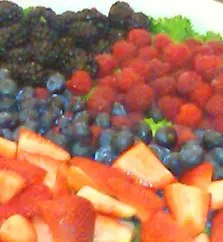
Antioxidants: Researchers on the Shifts in Our Understanding
Evolving research on antioxidants is turning aside earlier studies and books on healthy eating. A new understanding of nutrients and compounds we valued as antioxidants is taking shape that will change how we look at what makes a food a healthful choice. Here, in the first sections of interviews with Alan Crozier, PhD, and Navindra Seeram, PhD, you’ll get essential background on how antioxidant research is changing.
First, you’ll hear from Navindra Seeram, PhD, a respected researcher on natural plant compounds in foods such as berries. He is Assistant Professor in the College of Pharmacy at the University of Rhode Island, and is studying how compounds in plant foods affect inflammation, diabetes and cancer. Alan Crozier, PhD, adds further insights. Dr. Crozier is a world-renowned researcher from the School of Medicine at the University of Glasgow in the UK, studying how plant compounds are digested and metabolized, and in what form they circulate in the body.
Following the video, read on for some thoughts on how to put this message in context for healthful eating.
Antioxidants as Anti-Aging Disease Prevention
We’ve focused on antioxidants as health protectors ever since the discovery of their ability to stabilize highly reactive molecules known as free radicals. Our bodies produce free radicals as part of normal body processes, and our exposure further increases due to environmental factors such as second-hand smoke, radiation and pollution. These unstable free radicals can create damage to our cells that leads to cancer, heart disease, dementia and other health problems.
Substantial laboratory evidence shows that by neutralizing free radicals, antioxidants can prevent this kind of cell damage. Observational studies of large populations usually show that people with diets high in foods that supply antioxidants develop less cancer than those whose diets focus on meat, sweets and other refined carbohydrates.
Initially scientists focused on a few antioxidant nutrients – vitamins C and E, beta-carotene and selenium. Then research brought a completely new dimension to how we looked at healthy food choices by showing that natural compounds in a variety of plant foods supply the vast majority of foods’ antioxidants. Researchers say that may help explain why adding just one or a few antioxidants in supplements does not show the cancer protection seen in people eating a plant-based diet loaded with protective natural compounds.
Searching for Peak Antioxidant Power
Since plant foods contain thousands of different nutrients and phytochemicals that can act as antioxidants, researchers began looking for ways to measure the total antioxidant effect of individual foods so it could be studied as part of foods’ impact on health. Several different methods were developed to measure antioxidant power (technically referred to as “antioxidant capacity”) of compounds and foods. You’ve probably most often seen vegetables and fruits rated by their ORAC (oxygen radical absorbance capacity) scores, but researchers also developed other tests, including TOSC, FRAP and TEAC to test antioxidant capacity. Countless books and articles (including some written by me) used ORAC scores to identify health-protective foods beyond those found by looking up content of vitamin C and other nutrients.
While unrefined plant foods are loaded with antioxidants, when it comes to comparing particular vegetables and fruits, different antioxidant testing methods produce slightly different results. So when people ask, “Yes, but what’s the vegetable or fruit highest in antioxidants?”, the answer varies depending on which testing method is cited. Besides, content of all phytochemicals and nutrients in vegetables, fruits, grains, beans, nuts and seeds varies with factors such as growing conditions, ripeness, and freshness. What you get from a food varies slightly each time, and is unlikely to precisely match the value reported based on an average of tested samples.
Labs versus Humans: The Trouble with ORAC

Tests of antioxidant power may not be able to measure how fruits & vegetables protect our health.
The problem with all of these tests of antioxidant capacity is that they are tests of what happens in an isolated laboratory environment; they can’t represent the effects of eating these foods. Actual effects vary with how much of the antioxidant compounds we absorb from foods, how long the compounds remain in our body and how much gets into our cells.
In fact, many of the natural plant compounds showing potentially health-protective effects in laboratory studies are unable to be absorbed from out of our digestive tract. However, they are broken down to form other compounds that can be absorbed and do circulate through the body.
This is another reason that laboratory tests of foods’ antioxidant capacity don’t match reality: Plant phytochemicals are broken down in large part by the healthful bacteria in our colon (the “microbiota”), and people differ in the particular bacteria that make up their microbiota. So different people eating the same fruit, vegetable or other plant food produce different amounts of absorbable protective compounds, and end up with different degrees of antioxidant protection.
What Happened to ORAC?
In 2012, the U.S. Department of Agriculture (USDA) withdrew the online database of foods’ ORAC values it had released in 2007 and later updated. In addition to the problems cited above, the decision reflects research showing that many of the health-protective effects of plant foods’ nutrients and phytochemicals may be unrelated to an antioxidant role. For example, research is identifying effects on cell signaling pathways that control inflammation, cell growth and self-destruction in abnormal cells.
Researchers active in the field say there’s been concern that ORAC scores were being used inappropriately in marketing campaigns and other message sources, conveying to the public an incorrect understanding of what science really shows about steps to protect health. They emphasize that fruits, vegetables, whole grain, beans, nuts and seeds are the backbone of healthy eating; it’s just our understanding of why that is changing.
Ronald Prior, PhD, who conducted research for the USDA for many years on antioxidant phytochemicals’ health-related effects, has now developed an updated database that lists ORAC values and total phenolic content of foods. It reportedly contains all data from the former USDA database and some additional foods. If you are curious about content of foods, you can access this information at www.oracdatabase.com. Just remember these points:
- Values more accurately reflect variation in content of compounds called polyphenols, not actual antioxidant effects in your body after eating the food.
- Whether you look at values per 100 grams of a food or per serving size, what you get from a food varies with the amount you consume. Especially when you look at ORAC values expressed per 100 grams, listings for spices or foods you eat in small amounts don’t reflect what you get from your actual serving.
What’s Next
Now that you are up-to-date on current understandings about antioxidants, come back for the rest of this series based on interviews with Dr. Seeram and Dr. Crozier. We’ll examine what these compounds on which we’ve previously focused as antioxidants do have to offer as protectors against cancer, heart disease and other health problems. And we’ll look at how you can use this information for eating choices that promote the health and vitality you seek….Yes, we’re taking nutrition from daunting to doableTM.
Click here to Subscribe and receive future research updates straight to your email inbox so you don’t miss a thing!
Resources
Here is the USDA statement explaining why it took down the ORAC database.
References
For a good review article about polyphenol compounds as antioxidants and how they may benefit health:
Hollman PC, et al. The biological relevance of direct antioxidant effects of polyphenols for cardiovascular health in humans is not established. J Nutr. 2011 May;141(5):989S-1009S.
4 Comments
Leave a Comment
Published : July 9, 2013 | Last Updated: March 1, 2024
Tagged: Alan Crozier, antioxidants, healthy diet, healthy eating, heart disease, inflammation, Navindra Seeram, plant-based diet, reducing cancer risk, researcher interviews, video interview
Meet the author/educator
I Take Nutrition Science From Daunting to Doable.™
As a registered dietitian nutritionist, one of the most frequent complaints I hear from people — including health professionals — is that they are overwhelmed by the volume of sometimes-conflicting nutrition information.
I believe that when you turn nutrition from daunting to doable, you can transform people's lives.
Accurately translating nutrition science takes training, time and practice. Dietitians have the essential training and knowledge, but there’s only so much time in a day. I delight in helping them conquer “nutrition overwhelm” so they can feel capable and confident as they help others thrive.
I'm a speaker, writer, and nutrition consultant ... and I welcome you to share or comment on posts as part of this community!



i’d like to see the complete interviews with each of these gentlemen. when it’s mentioned that the USDA has withdrawn it’s information on the antioxidant activity of the popular list of fruits and vegetables that have heretofore been thought to scavenge free radicals directly from the body, that is major news. i’ve seen unique portions via two of your links, but it would be beneficial to see the complete messages from each professional.
Thank you for taking time to comment here and perhaps start a discussion with other readers.
Did you see all three of the blog posts featuring interviews with Dr. Seeram and Dr. Crozier? Together, these three segments constitute virtually my complete interviews with these two distinguished researchers. I simply cut them into shorter segments to keep final video length to something that people generally seem to find reasonable to view. There was really no additional information shared; both simply clarifyied that compounds like polyphenols that we’ve thought of for years as “antioxidants” based on what they do in a laboratory hold great potential to promote health…but not through directly acting in our bodies in the same way they do in studies of isolated cells.
If you’d like to read more about the USDA decision to withdraw the ORAC database, I urge you to follow the link I provided here in my post, as more detail is provided there.
Again, many thanks for spending time at Smart Bytes® and for your comments.
Karen
[…] choices that didn’t make this list. In previous Smart Bytes® posts we’ve looked at why ORAC antioxidant scores are also not solid ground for rating vegetable and fruit choices. A simple goal: make vegetable and fruits a big part of […]
[…] phytochemicals in plant foods we hear about as antioxidants make any difference for health? In Part 1 of this series on antioxidant compounds, Navindra Seeram, PhD, and Alan Crozier, PhD, explained why laboratory […]